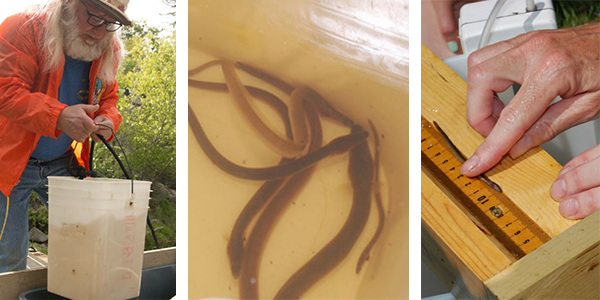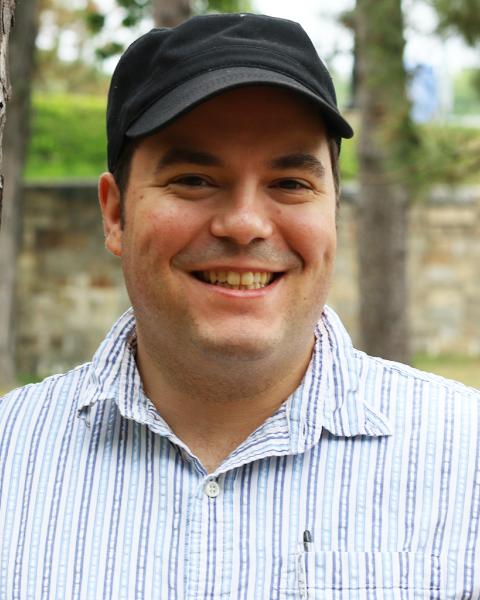A Big Journey, Close to Home
Each spring, New Hampshire’s coastal rivers are host to an incredible migration. Young American eels, hatched 1,000 miles away in the Atlantic Ocean, swim upstream as far as they can, where they grow to adulthood in freshwater streams and lakes.
"Once you get to know what glass eels are and where they start and how they get here, it’s just so fascinating."
Most people have no idea that a leg of this fantastic journey occurs in our coastal rivers, but the dedicated volunteers of New Hampshire Sea Grant and New Hampshire Fish & Game’s eel monitoring program are keenly aware.
“Once you get to know what glass eels are and where they start and how they get here, it’s just so fascinating,” says Kaye Jaus of Alton. She and her husband, Craig, are two of the three dozen or so volunteer eel monitors who track how many eels pass through one of New Hampshire’s two collection sites each day during the migration.
Glass eels are simply eels at a young life stage – they’re essentially transparent and small, about four inches long. By the time they’ve hit New Hampshire’s coast, they’ve already done a lot of growing. Eels spawn in the Sargasso Sea and larvae drift on ocean currents until they arrive here. The juvenile eels then swim up freshwater streams, and, as they grow, eventually become yellow eels, according to Caitlin Mandeville, citizen science outreach coordinator with New Hampshire Sea Grant and UNH Cooperative Extension.
“We’re seeing the eels just as they’re starting their migration upstream,” she says.

Citizen science informs management decisions
Monitoring eels helps Fish & Game officials set catch limits and plan out the commercial fishing season. It also provides a window into the health of a native species.
Volunteers like Kaye and Craig monitor the collection site in Durham each day during the migration. A passive capture system collects the eels in one place, and volunteers count the number of eels passing through. Some eels are briefly anesthetized (a little clove oil puts them safely to sleep) so that volunteers can measure the eels’ length and pigment levels. Those eels are revived, reunited with their companions, and then placed back in the stream to continue their journey.
It may take decades for the fish to grow from the delicate glass eel stage to the beefy, three-foot long silver eel stage of maturity. It is then that they leave the Granite State and swim back to sea, where they spawn the next generation and die.
The number of eels caught each day varies – Mandeville says volunteers have catalogued as many as 600 eels in a single day. Other days, the collection sites are empty. That’s part of the reason for the monitoring.
“Getting a better understanding of that variation is another one of the project’s goals,” Mandeville says. “Eels are a native species with a fascinating life cycle. Getting to know this creature that’s unseen but is truly interesting really resonates with volunteers.”
Volunteer science makes a difference
Kaye and Craig are longtime participants in the Coastal Research Volunteers (CRV) program with a passion for the outdoors. “When we learned about the coastal research program, we wanted to get involved in something that included being outdoors, but also made us feel like we’re contributing to the university and the environment,” Kaye says.
The Jaus’ journey as volunteers has been as epic as the life of the eels they monitor, though on a somewhat smaller scale. Kaye and Craig have volunteered with clean-ups at Mount Major, piping plover monitoring in Seabrook and Hampton, the New Hampshire Volunteer Beach Profile Monitoring Program and other efforts hosted by Sea Grant and Extension.
“These programs wouldn’t happen if people didn’t volunteer,” Craig says. “And you get to meet so many different people. Everybody has this passion. We want to wake up America, wake up the world to the fact that there’s more to life than dollar signs. We need our planet.”
Their passion for volunteering has inspired their family, too. They’re planning on bringing their six-year-old grandson with them during an upcoming eel monitoring shift.
“He’s a budding naturalist – he checks under all the rocks because he loves salamanders. He’s interested in snakes, he’s interested in the environment, and us being involved in the environment helps him, too, I think,” Kaye says. If his enthusiasm holds, it could be the start of a whole new cycle of volunteerism.
Subscribe to the Coastal Volunteer Newsletter
